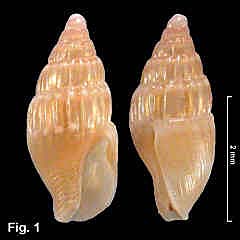|
|
|
|
|
Zafra smithi (Angas, 1877) Description: Shell solid, translucent, whorls rounded, aperture more than 1/3 shell length. Axial sculpture of strong ribs; on last third of body whorl these are weaker and irregularly spaced or restricted to top third of whorl. A spiral cord sometimes present below suture; about 10 spiral cords on base. Outer lip sinuous in profile, not thickened externally; thickened internally by a large nodule below sinus. Columella callus sharp edged, without denticles; deep groove at top of columella deep inside aperture. Siphonal canal slightly upturned, notch shallow. Colour fawn or white, with 2 spiral bands of white spots on axial ribs, one below suture, the other at middle of body whorl. Size: Up to 3.5 mm in length. Distribution: Indo-West Pacific. In Australia, occurs in Queensland and NSW, as far south as Twofold Bay. Habitat: Known from shell sand and algae washings, beach and intertidal to 10 m. Common. Comparison: This species has a large nodule but no other denticles inside the outer lip. Z. troglodytes has 5-9 denticles. Z. atrata has about 5 denticles, and is larger and dark brown. Remarks: This may be a form of Zafra hervieri (Pace, 1902), which occurs in the tropical Indo-West Pacific, but the colour pattern does not match any of the colour forms of that species described by Sleurs (1987). Fig. 1: Middle Harbour, Sydney, NSW (C.32677) |
